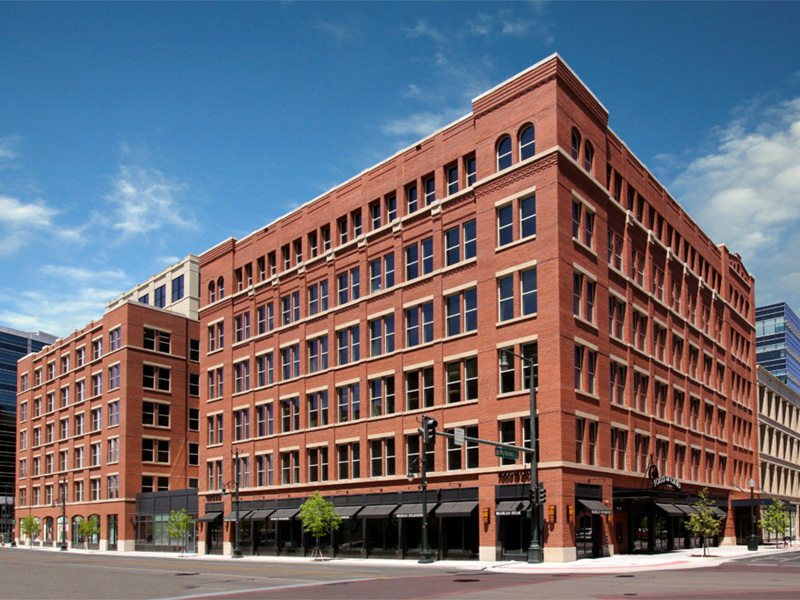Closing the Gap
Green building continues its frenetic pace globally, and the numbers are staggering.
By Amanda Marsh

RAF Pacific Group’s dis-tri-bute, a creative office and industrial project in Carlsbad, Calif., must comply with strict local rules under the city’s climate action plan.
Green building continues its frenetic pace globally, and the numbers are staggering. Each day, 2.2 million square feet achieve LEED certification, while respondents to Dodge Data & Analytics’ World Green Building Trends 2016 SmartMarket Report say 60 percent of their projects will go green by 2018.
But despite the number of commercial real estate owners jumping on the sustainability bandwagon, the process of going green remains fraught with challenges. At the same time, it is no longer a differentiator for Class-A assets, which make up the bulk of green buildings.
“Sustainability is not a novelty anymore,” said Ilana Judah, principal & director of sustainability for FXFOWLE, the architecture and planning firm. “We have to convince clients that don’t have requirements to pursue LEED that there’s still value in doing so.”
In fact, building codes and standards are now often designed to make new buildings or improvements green by design, pointed out CBRE global director of corporate responsibility David Pogue.
“So if you want to be different, that often requires more cutting-edge activities, which require more risk,” he said.
The introduction of new technology is one such risk, despite building owners’ and managers’ interest in improving efficiency.
“People in our industry don’t generally like to be the first to try any new technology,” he said.
As is always the case with innovation, green technology’s latest strides present both opportunity and challenges. For example, until a few years ago, light fixtures were typically fluorescent, and updating to more efficient lights and fixtures was fairly routine, noted Gary Holtzer, Hines’ senior managing director & global sustainability officer.
Today, fixtures are being upgraded to solid-state lighting, like LEDs. Technology has advanced to the point where each fixture could soon have its own IP address to allow for monitoring performance and even send out a signal when it needs repairs.
“These types of technological changes have led to major changes in the recruitment and training of on-site building personnel, who more than ever before are required to understand increasingly complex technologies and how they interact,” he said. “We are seeing this across all aspects of a building’s operations.”
Higher Education

Class A buildings, like 1515 Wynkoop in downtown Denver, continue to dominate the sustainability movement. Owned by Invesco Real Estate and managed by Hines, the office asset recently earned a LEED for Existing Buildings Platinum certification.
Despite the broad adoption of sustainable practices, a large gap remains between Class A and Class B properties. Maastricht University and CBRE’s 2016 National Green Building Adoption Index shows that in the 30 largest U.S. office markets, the growth of Energy Star-and LEED-certified space has increased slightly since the end of 2014. However, total floor space certified by the U.S. Green Building Council decreased from 20.1 percent to 19.6 percent, including newly constructed buildings.
“The overall results again show that the adoption of green building practices … is significant, but the pace of buildings designated as ‘green’ has been slowing down over the past two years,” the report states. “This does not imply that buildings are starting to perform worse than before, but it perhaps rather reflects the fact that only a certain fraction of the building stock can obtain a sustainability or energy efficiency certification.”
Pogue maintains that the embrace of sustainability in the Class B market is only just beginning.
“Since it often takes extra cost and effort, there needs to be a defined motivation to do this,” he said. Owners of Class B assets are generally less likely to be pressured by financial partners to invest in sustainability. Moreover, he noted, Class B properties may be less likely to attract tenants that make sustainability a top priority. And investors in Class B assets are often smaller shops that lack the horsepower to focus on green practices.
“And since they actually represent the vast majority of buildings and square footage, this is one of the issues the industry is concerned about. How do you encourage better practices? We are still searching for that answer.”
Stuart Brodsky, clinical assistant professor at New York University’s Schack Institute of Real Estate, agrees that while there is plenty of literacy about sustainability and green building issues in the Class A market, the learning curve is still considerable beyond top-tier buildings and urban core markets. Bringing more of the Class B market on board will not happen easily.
Furthermore, all constituencies, and not merely investors in Class B assets, would benefit from additional education, especially the brokerage, development and architectural communities, said Judah. Data assessment and real-world case studies of building performance offer the most effective way to accomplish this.
Major real estate associations, educational organizations and service providers are all good resources, Pogue noted. And on the ground level, a continuous exchange of ideas among owners, managers and tenants is crucial.
Cost Conundrum
While experience makes evaluating the costs and benefits of sustainability easier than it once was, penciling out the numbers is sometimes less than clear cut. One hazard is overpromising financial rewards, Brodsky argues.
“Green can be a squishy term and easily misunderstood,” he said. “There are so many aspects and shades of green. Vendors and products need to define what they offer with great clarity, so owners and managers can understand what they’re buying and how to create value.”
And government agencies at all levels are holding buildings to more stringent standards.
“The challenge of making sustainable practices pencil out is associated with how far we move the bar and how rigorous we make the process of getting more sustainable,” Brodsky added. “It’s a question of what owners and developers need to do in order to get a certificate of occupancy.”
When RAF Pacifica Group develops industrial, creative office and mixed-use projects in San Diego County, it answers to both state and local laws. The city of Carlsbad requires developments over a designated size to implement practices that reduce greenhouse gas emissions. Developers must also install solar panels and contain all storm water and other runoff.
“The challenge is, we build spec and don’t know what type of tenant is going to occupy the building yet,” said founder & principal Adam Robinson.
RAF Pacifica has yet to see a tenant choose a building based on sustainability, at least on the industrial side. Since few industrial buildings include features like solar power and EV charging stations, it’s difficult to tell whether such additions provide a competitve advantage by attracting tenants.
Additionally, it is unclear how well the porous concrete RAF Pacifica is using to manage storm runoff will hold up after four or five years of use, or what the long-term maintenance costs will be.
As a major consumer of energy, lighting, too, demands continued attention. “Even though technology is more efficient now, there’s still a tremendous opportunity to improve,” Brodsky asserted. Lighting accounts for more than a quarter of electricity use in office buildings, he noted, “and it could often be reduced by as much as 30 percent through an investment with a two- to two-and-a-half-year payback.”
Another area for opportunity and savings is rehabbing older buildings to new standards, Robinson added.
Judah called for a greater focus on incentives, such as financial rewards for owners whose properties cut consumption by a certain minimum—say, 20 percent.
The steady adoption of benchmarking is making such incentives more practical. More than 15 cities require owners to disclose energy use periodically, including New York City, Chicago, Seattle and Los Angeles, Pogue noted.
“If cities and communities had this granular usage information, they could better identify buildings that could best benefit from energy-efficiency practices, allowing the owners to be approached by utility companies targeting their rebate programs, as well as local tech companies,” he explained.
Healthy Outlook
Staying ahead of the competition today demands not merely efficient operation but environmental, social and governance (ESG) performance. Sophisticated owners, investors and managers focus on how to improve the occupant experience through management practices.
“We are seeing firms energetically compete to recruit and retain the best talent,” Holtzer said. “With human talent providing the momentum for many of these firms’ success, they are paying closer attention to the health and wellness of their employees.”
These firms are seeking locations and amenities that fit their health initiatives, such as fitness centers, locker rooms, natural light and walkability. The upshot, Holtzer said, is that “It requires us to rethink the workplace.”
Evaluating the fnancial benefits of investing in health and sustainability requires some perspective, however. As Pogue pointed out, occupancy costs often outweigh energy outlays by more than 100-to-one. “If we were able to reduce energy use by 50 percent, those economic benefits would be dwarfed by the benefits of even a single percentage improvement in productivity,” he said.
However, analyzing how a building affects productivity is not quite provable yet, he conceded; the ROI for providing a workplace that promotes performance is harder to demonstrate than cost savings achieved by switching out lightbulbs.
Two stakeholders are especially important when it comes to ESG performance, Brodsky pointed out: the new generation of graduates who want to work with ESG-conscious companies, and institutional investors requiring screening of investments and development partners for sustainable practices.
“If you’re an owner or developer, you can’t participate in attracting institutional investors if you are not literate about ESG issues or sustainable performance of your buildings,” he said.
Originally appearing in the April 2017 issue of CPE.







You must be logged in to post a comment.